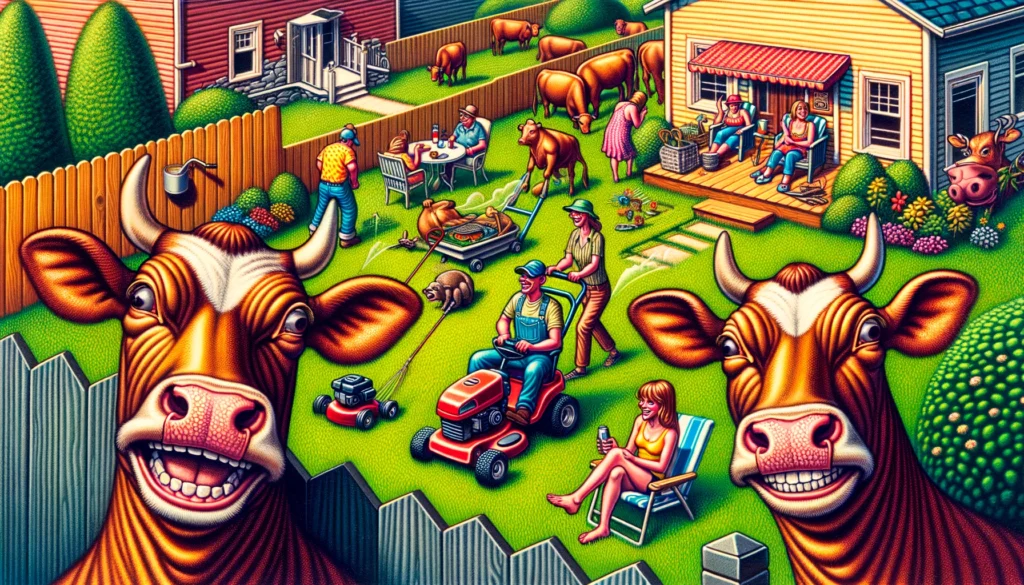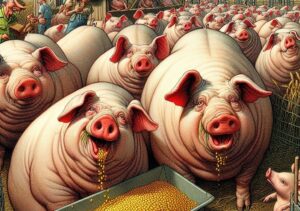
When Cows Become Neighbors A vibrant and detailed close up illustration depicting a humorous and whimsical scenario where cattle have become neighbors to humans. The scene shoul 1.webp.webp
The Grass is Greener on the Bovine Side: Neighborly Life in Wichita Falls
Cattle Calls and Morning Rituals: A Day in the Life of Wichita County’s Four-Legged Residents
Wichita Falls, TX — In the bucolic sprawl of Wichita County, the concept of “keeping up with the Joneses” takes on a whole new meaning. Here, instead of peering over the fence to critique your neighbor’s unkempt lawn or garish new paint job, you’re more likely to catch a glimpse of Bessie the cow, casually grazing and providing a live ‘moo-torial’ on how to keep your grass in check the natural way. Yes, in these parts, your next-door neighbor just might be a bovine beauty.
Living next to cattle has its perks. For starters, they’re remarkably punctual with their routines, beating even the most steadfast milkman to the punch. Their day starts with the sun, a morning ritual that involves a communal gathering at the trough for a hydrating kick-start. And unlike human neighbors, who might blare loud music at inopportune hours, the cattle’s soundtrack is a consistent, soothing symphony of mastication – a pastoral white noise machine of sorts.
Living in a neighborhood where cattle are your neighbors means never running out of milk for your morning coffee. Just don’t forget to close the gate; nobody wants a surprise visit from a curious cow in the kitchen.

Speaking of noise, cattle are the epitome of discretion. Eavesdropping? Not their style. They prefer a good, old-fashioned face-to-snout conversation across the pasture. A cow’s stare may be intense, but it’s simply their way of showing interest – or pondering whether your sweater is a chic new trend or a potential snack. Cows, you see, have an eye for detail and a taste for fashion, quite literally.
In the realm of social etiquette, these gentle giants take the cake – or should we say, the hay. They respect personal space, save for the occasional curious nudge of a wet nose, and even then, it’s usually because they sense you’ve got a treat. Cows have a way of winning hearts without saying a word, their soulful eyes radiating a warmth that can turn a tough cowboy into a softie.
But it’s not just the endearing personality traits that make cattle exceptional neighbors; their contribution to the agriculture in Wichita County is pivotal. Acting as the cornerstone of local farming operations, they serve not only as providers of dairy and meat but also contribute to the land’s fertility. In essence, cattle are living, breathing, fertilizing machines, transforming grass into prime compost material. They’re the unsung heroes of crop nutrition, facilitating a full-circle dining experience where they enjoy the crops, and the crops, in turn, enjoy them.
Forget about noisy neighbors; when cattle become your next-door pals, the only noise complaints you’ll have are the occasional “moo” and the sound of hooves on the fence.
One of the more amusing behaviors often observed is their surprisingly good memory, particularly when it comes to meal times. They could teach many a forgetful spouse the value of punctuality. And while residents might have difficulty remembering the plethora of online passwords, cattle remember the precise location of the best grazing spots and the quickest route to the watering hole.
However, let’s not romanticize things too much – cattle, like any neighbor, can have their moments. They might not borrow your lawnmower and forget to return it, but they can certainly push over a fence or two when the grass looks greener on the other side. And when it comes to lawn decorations, these creatures can be a bit of a bull in a china shop, if you’ll pardon the expression. That said, unlike human neighbors, they won’t judge your questionable choices in garden gnomes.
Who needs alarm clocks when you have a chorus of cows greeting the sunrise every morning? Living in a neighborhood where cattle are your neighbors means waking up to the sound of nature’s moo-sic.
The agricultural landscape in Wichita County is painted with the broad strokes of these bovine residents. The importance of understanding their behavior is not just for the amusing anecdotes they provide but also for managing a successful farming operation. Recognizing the signs of stress or illness in cattle, predicting their movements, and knowing when they are content are skills honed by local farmers over generations. This knowledge ensures that the cattle live happily and healthily, which in turn guarantees the highest quality of produce for the market.
It’s clear that in the neighborly pecking order, cattle may very well be at the top. They don’t host loud parties (unless you count the occasional bellowing concert), they keep your secrets safe, and they contribute significantly to the local ecosystem. So, if you find yourself moving to Wichita County, don’t be surprised if your new neighbors are a herd of cattle – just remember to greet them with a friendly hat tip and perhaps a tasty hay biscuit. After all, when in cowboy country, do as the ranchers do.
When cattle become neighbors, you know you’re living in a pasture paradise where the grass is always greener and the conversations are a lot more moo-ving.
As we leave the pastures of Wichita County and the amiable cattle behind us, let’s gear up to observe another rural spectacle. Just over the rolling hills, as the first leaves of autumn begin to fall, a different kind of migration is taking place. It’s not the geese flying south for the winter that captivates the locals; it’s the annual ‘Great Tractor Migration’. Stay tuned as we trade our cowhide boots for tractor treads and delve into the agricultural odyssey that sees these mechanical beasts traverse the landscape, as essential to the rhythm of rural life as the cattle themselves.
Our Reporters are Currently Following these Stories:
- It’s not just a rural idiom anymore; when cattle become neighbors, you’ll find yourself attending block parties with a whole herd of bovine buddies.
- Who needs a lawnmower when you have a herd of grazing neighbors? Just be prepared for some unconventional lawn maintenance methods, including the occasional cow-pat fertilizer.
- Living in a neighborhood where cattle are your neighbors means never running out of milk for your morning coffee. Just don’t forget to close the gate; nobody wants a surprise visit from a curious cow in the kitchen.
- Forget about neighborhood watch programs; when cattle become neighbors, you’ll have a whole herd of vigilant bovines keeping an eye on things and chewing the cud.
- When cattle become neighbors, property lines become a bit more flexible, and the concept of “mine” and “yours” takes on a whole new meaning. Just try explaining that to the cow in your backyard.
- Who needs alarm clocks when you have a chorus of cows greeting the sunrise every morning? Living in a neighborhood where cattle are your neighbors means waking up to the sound of nature’s moo-sic.
- Forget about fancy landscaping; when cattle become neighbors, your backyard becomes a veritable buffet of fresh grass and dandelions. Just make sure to keep your garden gate locked, or you might find your tomato plants disappearing faster than you can say “moo.”
- When cattle become neighbors, you’ll quickly learn that the key to peaceful coexistence is a good fence and a healthy sense of humor. After all, living in a neighborhood where cows roam free is anything but boring!
- When cattle become neighbors, you know you’re living in a pasture paradise where the grass is always greener and the conversations are a lot more moo-ving.
- Forget about noisy neighbors; when cattle become your next-door pals, the only noise complaints you’ll have are the occasional “moo” and the sound of hooves on the fence.
Originally posted 2009-01-03 09:03:13.
Originally Published at FarmerCowboy.com
2024-10-30 18:30:58
Karl Hoffman is a distinguished agriculturalist with over four decades of experience in sustainable farming practices. He holds a Ph.D. in Agronomy from Cornell University and has made significant contributions as a professor at Iowa State University. Hoffman’s groundbreaking research on integrated pest management and soil health has revolutionized modern agriculture. As a respected farm journalist, his column “Field Notes with Karl Hoffman” and his blog “The Modern Farmer” provide insightful, practical advice to a global audience. Hoffman’s work with the USDA and the United Nations FAO has enhanced food security worldwide. His awards include the USDA’s Distinguished Service Award and the World Food Prize, reflecting his profound impact on agriculture and sustainability.



